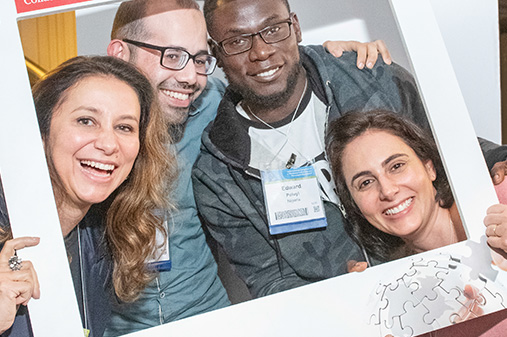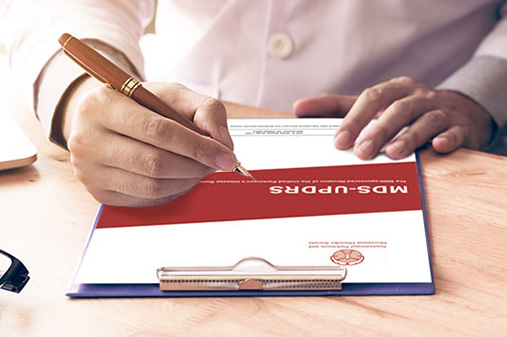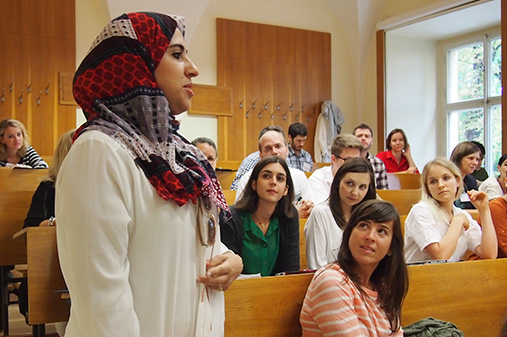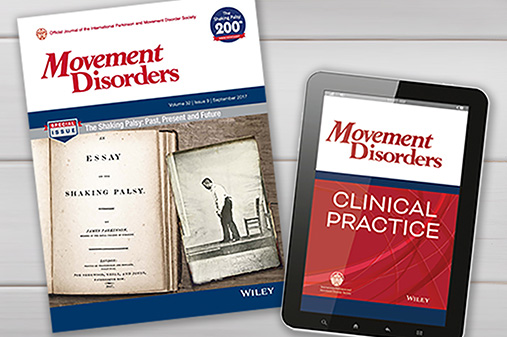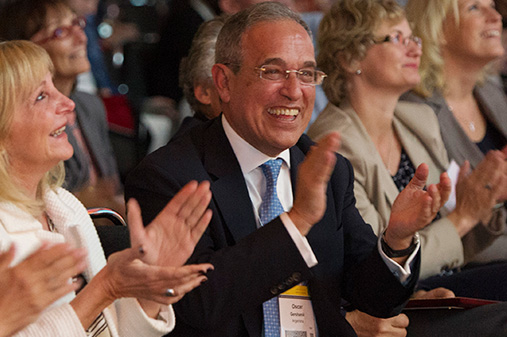Intraventricular infusion of anaerobic dopamine
Dr. Hugo Morales Briceno: [00:00:00] Welcome to another episode of the MDS Podcast, the official podcast of the International Parkinson and Movement Disorder Society. I'm your host, Hugo Morales, and today's episode will explore a pioneering approach to dopaminergic treatment delivery. Although dopamine deficiency has long been associated with Parkinson's disease.
Oral dopamine cannot cross the digestive and blood-brain barriers as it degrades rapidly. However, a novel experimental strategy pushes this limits by delivering dopamine directly into the brain. Today I have the pleasure of talking to Professor David Devos from the Parkinson's Disease Center of Excellence at the University of Lille France.
View complete transcript
Professor Devos and his team have recently published a paper entitled. Intracerebroventricular anaerobic [00:01:00] dopamine in Parkinson's disease with L-DOPA related complications, a phase one and two randomized controlled trial published in Nature Medicine Journal. Professor Devos, thank you very much for coming today to our podcast.
Prof. David Devos: Hello. Thank you very much for your invitation.
Dr. Hugo Morales Briceno: It is a pleasure. Now let's start talking about the background and how you have designed this clinical trial, but also for readers and listeners to know about this new compound, the A-dopamine.
Prof. David Devos: Yeah. As we all know, Parkinson disease is defined by a dopamine deficiency in a nigrostriatal pathway. And we know, that dopamine has never been used for 60 years. Because first it does not cross the digestive barrier or the blood brain barrier. And also because it is rapidly oxidized.[00:02:00]
So it prevents from using dopamine for several years. And we also know that the oral backbone treatments currently use, or the levodopa or dopamine agonist are leading to complications. We know that 50% of people under dopaminergic agonist have addiction impulse control disorders, and 50% of people under levodopa developed complication with fluctuation dyskinesia.
Within five years and 80% after 10 years. So we have developed with a new therapeutic strategy with InBrain Pharma, the startup that I co-funded to overcome these two challenges first in anaerobic dopamine which allow stabilizing the dopamine to avoid oxidation. So it's a new delivery mode with intracerebroventricular administration.
And we put a small catheter directly [00:03:00] in the third ventricle beside the two striatum.
Dr. Hugo Morales Briceno: And with this A-dopamine I assume that there was a good preclinical evidence that improve motor function in this models.
Prof. David Devos: Yeah, so we started with the mouse model the MPTP model and then the 6-hydroxydopamine rat model and then the MPTP monkey model. And in the three models we were able to find the good dose of dopamine and to restore in mice and rat and monkey 100% of the motor handicap. Notably the limp handicap and without inducing any dyskinesia.
And so thanks to this preclinical data, we started a phase one, phase two clinical trial in Lille, in the north of France. And in 12 people, the primary criteria was, to a measure for seven days. the [00:04:00] fluctuation dyskinesia, the off period. And we observed that first of all the intracerebroventricular administration was really safe.
It's a neurosurgical procedure based upon the DBS, but less invasive, less dangerous, easier, and which lasts four hours. And the safety profile of A-dopamine was amazing. We have no real severe adverse event. Only a slight nausea or sleepiness. And then we observed after this phase one that we need a dose from 100, 150 to 2 50 milligram per 24 hours.
We were able to find the best dose during the day and the best dose during the night according to the needs of the patient. And then they enter phase two. So it was a crossover, randomized trial with one month with. Oral treatment or one month with A-dopamine with the [00:05:00] remaining oral treatment.
And we observe benefit with an extra 4.4 hours of perfect control without any dyskinesia any off. And it was also six hours, more than six hours of good autonomy, meaning that the patient were either perfect or slight off or slight dyskinesia. And as compares or optimize oral treatment, and this has never been seen with other devices therapies.
Of course, this is a phase one, phase two trial, so this need to be confirmed. But importantly with this central personalized, simple implementation of dopamine. We in fact, invented a third therapeutic approach, which is the pharmacological neuromodulation, and this is indeed a word premier, that the feasibility, the high efficacy and the grid safety of direct modulating the neurotransmitter.
So we prove that we are able now to directly modify and modulate neurotransmitter in brain [00:06:00] as exemplified with dopamine for Parkinson's disease.
Dr. Hugo Morales Briceno: Yeah. Can I ask, based on an experience for other trials, including for deep brain stimulation the therapy itself is effective, but sometimes you come across problems with the hardware or the equipment itself rather than the therapy. So did you find anything troublesome regarding the pump or for example the connection between the pump and the ventricles?
Prof. David Devos: Yeah, indeed. First of all, as compare with DBS, we don't have any risk of troubleshooting. With DBS, you have to reach, less than one millimeter to be sure that you are in the posterior later part of the subthalamic nucleus. This is not the case here. It's an easy procedure so you don't have this risk of troubleshooting and so you are sure to have 100% of benefit.
Not only regarding the hardware and the pump and the catheter we had no problem with the catheter. It's a very small wound and it's [00:07:00] only crossing three centimeter of the cortex, so it's not very invasive and then it's only in the ventricle system. On the 12 people, we have no problem with catheter, no problem of infection.
And the pump where the biocompatibility between the abdominal pump has been checked and it was okay. And the pump half life is around five to eight years. So like DBS, you need to replace the pump. Indeed, you are right. It is possible to have a pump dysfunction and then like the peacemaker you need to restore it.
And it's a one hour surgical procedure.
Dr. Hugo Morales Briceno: I have a more practical question. This is something that , you may have experienced as well with infusional therapies intestinal gel or even subcutaneously Levodopa. There's always a titration phase where you're trying to find the right. dosage. What was your experience with this A-dopamine delivery?
How did you find the, that window where the patients were more controlled?
Prof. David Devos: Yeah, this [00:08:00] is a very good question. It's like George Cotzias, you remember the man in New York City who increased titrate the dose of developer for the first time and prove with a randomized control trial that was effective. We have the same aspect here. We need to take time to titrate the dose of dopamine and to reach high dose to have a very high control.
So it's the same spirit here. So we titrate during two or three months and we slowly increase the dopamine 10 milligram twice a week and doing that. It is very well tolerated. You have sometime a little nausea for one day and that's it, and little sleepiness. And, but if you titrate too rapidly, then you have more vomiting or sleepiness or this kind of adverse event.
So when you start also levodopa in the early PD patient at the time of diagnosis, you need to increase the dose slowly. So this is the same spirit here. And then it allowed to find the minimum efficient dose and is the same, you know, [00:09:00] like any psych drug.
Dr. Hugo Morales Briceno: Can I ask you a question? Now that you've seen these patients in the clinical trial and you had the chance of following them up, I remember reading is it nearly four years that you follow these patients after the infusion?
Prof. David Devos: Yeah, you are right to underline this. In fact, you can say it's only a phase one, phase two trial on 12 people. So cautious interpretation, and it is true, but we have a long term follow up, more than four years with a lot of refill. I have to say that, the patient have a refill, so it's a transcutaneous refill at home by a nurse.
It lasts, you know, 10 minutes and every week or two weeks. And so we have more than 1000 of refill without any infection, any problem. And it's a very comfortable for the patient. And and so with a long term follow up. We also observe that we have no tachyphylaxis. No treatment failure or no need to increase the dose [00:10:00] constantly because the effect i is last so you, we have a major control of the patient.
Obviously you can see patient that remain totally stable and very autonomous, and the other have other non dopaminergic complication, which are not controlled by dopamine. But remarkably also, we observed that the levodopa and the dopamine act differently. In fact when we put the patient under A-dopamine, we reduce in the phase one, phase two trial, we reduce the oral dose by 60%, which is something.
But then on the long term, some patients were on monotherapy of a-dopamine, so without any oral treatment. And we observe that we never induce dyskinesia, even if you put very high dose of A-dopamine, you never induce a dyskinesia and were calm, no addiction. So we observe that in fact L- dopa is not equal to dopamine.
In fact, they act differently when you give [00:11:00] a dose of levodopa, either transcutaneously or oral, you induce dyskinesia in this patient, which is not the case with A-dopamine. So they have a different mechanism of faction. And in fact, it was also very interesting to observe that in people having dyskinesia without reducing the oral treatment, just putting A-dopamine small dose, we were decreasing dyskinesia.
So it's a double action of A-dopamine. Reducing dyskinesia itself and reducing bradykinesia as well.
Dr. Hugo Morales Briceno: That's a very fascinating finding. Who knows, but it could be a sort of downstream pharmacodynamic effect or the central pharmacokinetics. But this is something that was exploring in further studies.
Prof. David Devos: In fact, it opens new field of research to understand. But in fact we believe that a large dose of levodopa. Is not metabolized in dopamine. Levodopa acts directly on some receptor, and there's new papers coming out showing that levodopa can act directly on [00:12:00] some like GPR14 3 receptor or other receptor.
And in fact, it's only a small dose of levodopa is metabolized into dopamine. So this explains different pharmacological profile of these two molecules.
Dr. Hugo Morales Briceno: Professor Devos I have a last question. This is also has practical implication. You were saying that you had an infusion rate for the daytime and then the nighttime. What was the ratio, what is the difference of that stimulation in your patients?
Prof. David Devos: We have a very pragmatical approach from the start because if we invented this treatment, it was just for the patient, because we said it would be better for the patient to have all the device inside the body, and in order to take, the bad drugs to, deliver is where the brain is needed.
So it's very pragmatical approach. And then for the dose, we were also very pragmatical. And though we increase the dose during the day and during the night until, let say I'm good. So some patient really don't need high dose of [00:13:00] dopamine at night. They are sleeping well. They don't have off period, so we remain at five milligram, 10 milligram during the night.
But some other people have a lot of off period at night and very high need of dopamine. And then for those patient we put something around 40, 50 milligram. And so we stop increasing the dose when they were controlled. But it is now important to validate this first clinical results.
And so we are setting up an international phase three study. That should start in 2026 on 170 patient with InBrain Pharma. And it'll be a trial, hopefully international, so US, Europe, and Asia.
Dr. Hugo Morales Briceno: That brings us to the end of today's episode, and I want to thank Professor Devos for sharing his insights about this novel strategy of dopamine delivery. Stay tuned for our next episode where we'll continue exploring the latest advancements in movement disorders. Until then, stay [00:14:00] curious and keep learning.
Prof. David Devos: Thank you very much.

David Devos, MD, PhD
InBrain Pharma & University Hospital of Lille
Lille University
INSERM
Lille, France

